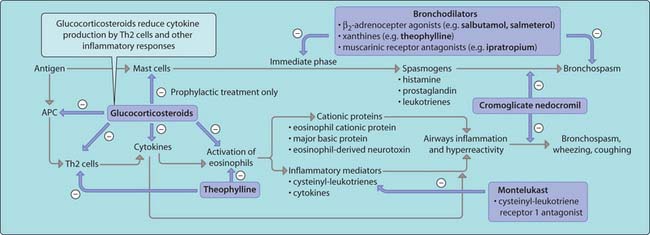21 Respiratory system
asthma
Asthma
Allergic asthma is the most common form of the disease (Fig. 3.21.1) but non-allergic asthma, which is not attributable to an allergic insult but results in a similar pathology and occurs later in life, is often more severe. Asthma can also develop following exposure to chemicals (e.g. isocyanates), when it is referred to as occupational asthma.
Drug treatment
Bronchodilators
Beta 2 adrenoceptor agonists
Activation of β2-adrenoceptors on airway smooth muscle results in elevated levels of intracellular cAMP, which activates protein kinase A and subsequently inhibits phosphorylation of myosin-like chain kinase, leading to relaxation. Activation of β2-adrenoceptors on mast cells inhibits mast cell degranulation and the release of mediators (Fig. 3.21.1). These drugs (salbutamol, terbutaline, fenoterol, formoterol and salmeterol) provide rapid and effective relief against acute bronchoconstriction caused by a wide range of stimuli, including allergens (Fig. 3.21.2). Salbutamol, terbutaline and fenoterol have relatively short (4–6 h) while formoterol and salmeterol have longer (12–15 h) durations of action following a single inhaled dose. The longer-acting drugs are useful in preventing nocturnal awakenings owing to exacerbation of the underlying disease process in the early hours of the morning and are of great benefit in providing undisturbed sleep. Side-effects of this drug class include tremor, hypokalaemia and tachycardia, but these wane with regular usage.
< div class='tao-gold-member'>
Stay updated, free articles. Join our Telegram channel

Full access? Get Clinical Tree






